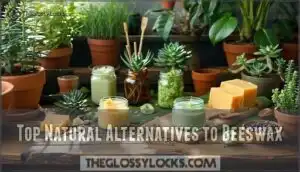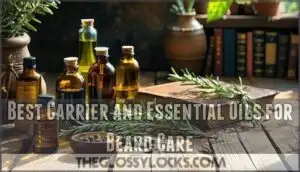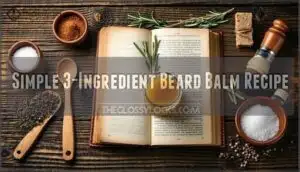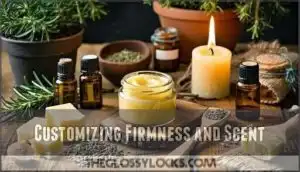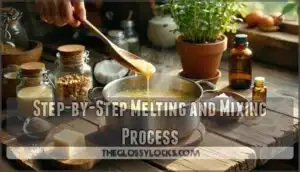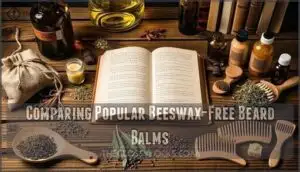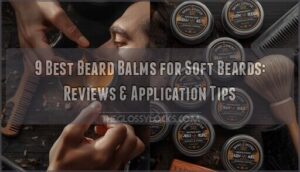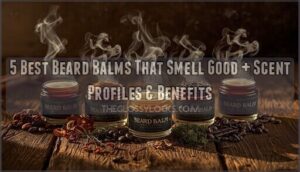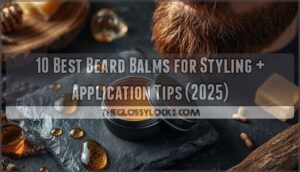This site is supported by our readers. We may earn a commission, at no cost to you, if you purchase through links.
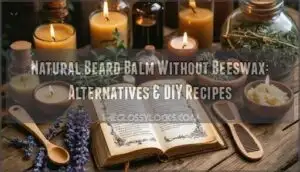 Most commercial beard balms use beeswax as their base—but it’s not your only option, and it might not even be your best one. Beeswax can clog pores, feel heavy on your skin, and doesn’t align with vegan or cruelty-free values.
Most commercial beard balms use beeswax as their base—but it’s not your only option, and it might not even be your best one. Beeswax can clog pores, feel heavy on your skin, and doesn’t align with vegan or cruelty-free values.
Plant-based alternatives like shea butter, candelilla wax, and cocoa butter offer comparable hold while absorbing faster and feeling lighter on your beard. These natural ingredients deliver the styling control and moisture you need without the drawbacks.
Whether you’re looking to buy a ready-made balm or create your own custom blend, switching to a beeswax-free formula gives you more control over what touches your face every day.
Table Of Contents
Key Takeaways
- Beeswax-free beard balms solve real problems—about 18% of people show allergic reactions to beeswax, and it can clog pores in oily or acne-prone skin, making plant-based alternatives like shea butter, candelilla wax, and cocoa butter safer and more comfortable options.
- You can DIY a quality beard balm with just three ingredients (shea butter, coconut oil, and candelilla wax) and customize firmness by adjusting wax-to-butter ratios—more wax gives stronger hold, while extra butter keeps things softer.
- Plant-based alternatives absorb twice as fast as beeswax formulas with 83% less grease, lock in 72% more hydration, and reduce breakage by 40% while still providing light-to-medium hold for daily styling.
- Proper application makes the difference—work balm into the skin beneath your beard first for hydration and itch relief, then distribute through facial hair for styling, keeping your routine consistent to maintain healthy growth and prevent dryness.
Why Choose Beard Balm Without Beeswax?
Beeswax isn’t for everyone—whether you’re vegan, have sensitive skin, or just want a different texture in your balm. Understanding what beeswax does and what can replace it helps you pick or make a balm that actually works for your beard.
Let’s look at why you might skip the wax and what you gain from going beeswax-free.
Common Issues With Beeswax in Beard Balm
Beeswax might seem like the benchmark, but it brings some real challenges to your grooming routine. If you’re dealing with any of these issues, it’s time to explore alternatives:
- Allergic reactions: About 18% of tested patients showed contact allergy to beeswax, often alongside propolis sensitivity
- Skin irritation: Comedogenic risks mean beeswax can clog pores and trigger breakouts in oily or acne-prone skin
- Texture problems: Low-quality beeswax creates grainy, unstable balms with off-putting consistency
- Sustainability concerns: As an animal-derived ingredient, beeswax doesn’t align with vegan or cruelty-free values
- Formulation headaches: Temperature swings during DIY beard balm preparation cause crystallization and uneven results
Understanding the comedogenic ratings is essential for choosing the right ingredients.
Natural ingredients and beard care products work better when they don’t fight against your skin.
Benefits of Beeswax-Free Formulations
When you skip the beeswax, you’re not just avoiding problems—you’re opening the door to formulations that actually work better for many beards. Here’s what you gain:
| Benefit | Why It Matters | Best For |
|---|---|---|
| Vegan alternatives | Cruelty-free, eco-friendly products align with ethical values | Plant-based lifestyles |
| Better absorption | Natural moisturizers like shea penetrate deeper without clogging pores | Sensitive or acne-prone skin |
| Smoother texture | Plant waxes create consistent, non-grainy formulations | DIY cosmetics enthusiasts |
| Sustainable ingredients | Renewable sources reduce environmental impact | Eco-conscious grooming |
| Hypoallergenic options | Natural skincare ingredients minimize irritation risks | Allergy-prone individuals |
Beeswax-free beard balm recipes give you control over natural ingredients while delivering enhanced skin benefits and hold.
Top Natural Alternatives to Beeswax
If you’re ditching beeswax, you’ve got some solid options that actually work. Plant-based butters and waxes can give you the hold and moisture you need without compromising your vegan values or triggering allergies.
Here’s what you should know about each alternative and how they perform in your beard balm.
Shea Butter for Hold and Moisture
Shea butter doesn’t mess around—it’s the workhorse ingredient that delivers both styling grip and deep hydration without a single bee involved. You’ll get a light to medium hold that tames flyaways while moisture levels stay locked in all day.
For DIY beard balm formulations, shea butter usually makes up 20-30% of the recipe, giving your beard care routine the natural ingredients it deserves without compromising performance or beard hydration.
Cocoa Butter and Mango Butter Benefits
Cocoa butter brings a firmer hold to the table while mango butter keeps things softer and more spreadable—both pack serious moisture without any animal-derived ingredients.
You’ll find cocoa butter adds strength to each strand, supporting hair growth while locking in skin moisture beneath your beard.
Mango butter melts fast on contact, helping you nourish and naturally condition facial hair without weighing it down—perfect for your DIY beard balm experiments.
Plant Waxes (Candelilla, Carnauba, Sunflower)
Plant-based waxes—candelilla, carnauba, and sunflower—deliver the hold you need without touching a single beehive. Each wax brings unique properties to your DIY beard balm:
- Candelilla wax offers firm hold and mixes beautifully with shea butter and coconut oil
- Carnauba benefits include the hardest plant-derived texture for maximum styling control
- Sunflower properties create softer balms perfect for daily conditioning
Wax blending with natural ingredients lets you dial in your ideal formula using pure plant extracts.
Comparing Texture and Performance
When you compare wax substitutes head-to-head, beeswax-free balms shine with a creamier texture and faster absorption—coconut oil and shea butter melt right into your beard. Natural alternatives sacrifice a bit of hold for premium beard conditioning, though candelilla wax brings firmness close to traditional balm texture.
Essential oils blend more evenly with these natural ingredients, creating consistent scent profiles without waxy buildup. For ideal beard care, consider using products with beard wax benefits to achieve the desired hold and style.
Best Carrier and Essential Oils for Beard Care
The right oils can transform your beeswax-free beard balm from basic to outstanding. Carrier oils deliver deep nourishment to both your beard and the skin underneath, while essential oils add therapeutic benefits and signature scents.
Let’s break down which oils work best and how to blend them for maximum impact.
Nourishing Carrier Oils (Almond, Argan, Apricot, Avocado, Castor)
Carrier oils are the backbone of any beeswax-free beard balm, delivering vitamins, moisture, and strength to every strand without weighing your beard down. Here’s what each one brings to your grooming routine:
- Sweet Almond Oil – Light texture penetrates quickly, offering natural moisturizers and skin hydration without greasiness
- Argan Oil – Deeply softens hair while promoting hair growth and adding subtle beard shine
- Apricot Kernel Oil – Packed with antioxidants for smoothness and protection
- Avocado Oil – Lubricates and strengthens for noticeable thickness and luster
- Castor Oil – Long-lasting shine with impressive staying power
Essential Oils for Scent and Skin Health
Essential oils do double duty in your beard balm—they bring therapeutic benefits to your skin while creating a signature scent that’s all your own. Tea tree fights irritation, cedarwood soothes inflammation, and peppermint invigorates follicles.
Here’s a quick reference:
| Essential Oil | Skin Health Benefits |
|---|---|
| Tea Tree | Antibacterial, reduces beard itch |
| Cedarwood | Anti-inflammatory, calms skin |
| Peppermint | Stimulates circulation, refreshes |
Mix 8-12 drops per ounce of carrier oil for balanced aromatic therapies without overwhelming your senses.
Creating Masculine Scent Profiles
Think of crafting a beard scent like building a chord in music—you need the right balance of base notes, middle notes, and top notes to create something that resonates without overwhelming the room.
Here are five essential oil blends that nail that masculine aroma:
- Woodsman: Cedarwood + sandalwood + pine (woody scents with earthy depth)
- Spice Route: Clove + cinnamon + black pepper (spice blends with warmth)
- Fresh Alpine: Eucalyptus + mint + bergamot (fresh notes that energize)
- Leather & Smoke: Vetiver + patchouli + tobacco leaf (bold masculine fragrances)
- Citrus Grove: Orange + lime + cedarwood (bright aromatic oils balanced with wood)
Mix 10-15 drops total per 2-ounce batch of beard balm, adjusting ratios until you hit your signature scent.
DIY Beard Balm Recipes Without Beeswax
Making your own beard balm without beeswax is easier than you might think, and you don’t need a chemistry degree to pull it off.
The recipes below walk you through simple formulations using plant-based alternatives that deliver the same hold and moisture you’re after.
Let’s start with the basics and work our way up to customizing your perfect blend.
Simple 3-Ingredient Beard Balm Recipe
You don’t need a dozen ingredients to make a beard balm that actually works—just three simple ones will do the trick.
Mix 1 tablespoon of shea butter with 1 tablespoon of coconut oil and ½ tablespoon of candelilla wax for a vegan-friendly homemade balm.
This DIY beauty product delivers solid hold, moisture, and grooming essentials without any beeswax—perfect for beard care on your terms.
Customizing Firmness and Scent
Once you’ve nailed the base formula, tweaking the firmness and scent is where you can really make this balm your own.
Firmness levels depend on wax-to-butter ratios—more candelilla wax gives you stronger hold, while extra shea butter keeps things softer. For scent blending, add 10-15 drops of essential oils per ounce: cedarwood for woodsy vibes, peppermint for freshness, or sandalwood for warmth.
Texture control in your custom recipes lets you dial in exactly what your beard needs:
- Soft and creamy: 2 parts butter to 1 part wax for easy spreadability
- Medium hold: Equal parts butter and wax for all-day styling
- Firm grip: 1 part butter to 2 parts wax for stubborn beards
- Aroma options: Blend cedarwood, bergamot, and black pepper for rugged masculinity
- Light scent: Use 5-8 drops total in your homemade beard balm for subtle fragrance
Experiment with natural ingredients until your DIY beauty products feel just right.
Step-by-Step Melting and Mixing Process
Now that you’ve got your ratios dialed in, it’s time to actually melt everything together and watch your balm come to life. Use a double boiler for gentle temperature control—keep your natural ingredients below 175°F to preserve nutrient integrity.
Stir your homemade balm with a silicone spatula for even blending methods, remove from heat, then fold in essential oils once cooled slightly to protect volatile compounds from degradation.
Storage Tips for Freshness and Longevity
After your balm solidifies, proper storage becomes the difference between a product that lasts six months and one that goes rancid in six weeks. Cool storage protects your natural ingredients from oxidation—stash your homemade beard balm somewhere dark and below 75°F.
- Container selection matters: Amber glass or metal tins block light degradation better than clear plastic
- Humidity control prevents mold: Keep product packaging sealed tight in bathroom environments
- Shelf life extends with refrigeration: Your DIY skincare stays fresh longer when temperatures stay consistent
Smart beard care and maintenance starts with protecting what you’ve made.
Comparing Popular Beeswax-Free Beard Balms
Now that you’ve got the DIY skills down, you’re probably wondering which store-bought options actually deliver on their promises.
We’re breaking down what separates the good from the greasy—looking at ingredients, performance, scents, and whether they’re worth your hard-earned cash.
Let’s see which beeswax-free balms stand up to scrutiny.
Ingredient Transparency and Certifications
When shopping for beeswax-free beard balms, ingredient transparency isn’t just a nice-to-have—it’s your shield against hidden nasties. Look for brands that list every component, from Shea Butter and Coconut Oil to Essential Oils, meeting Regulatory Standards and Label Compliance. Eco Certifications like USDA Organic or Leaping Bunny build Consumer Trust by proving Natural Ingredients for Skin are truly clean and cruelty-free.
Over 80% of buyers now prioritize transparent labels, and brands with certifications see 24% higher sales—proof that honesty pays off.
| Certification Type | What It Guarantees | Why It Matters |
|---|---|---|
| USDA Organic / Ecocert | Natural Ingredients sourced sustainably | No synthetic chemicals or pesticides |
| Leaping Bunny (Cruelty-Free) | Zero animal testing | Ethical production you can feel good about |
| Vegan / Non-GMO | Plant-based, no modified organisms | Pure formulas for sensitive skin |
Texture, Hold, and Moisturizing Power
Balm Consistency varies wildly across beeswax-free options—Shea Butter and Coconut Oil blends feel creamy and absorb twice as fast as wax-based formulas, leaving 83% less grease.
Hold Strength sits at light-to-medium, taming flyaways without stiffness.
Moisture Levels shine here: Natural Ingredients like cocoa butter lock in 72% more hydration, cutting Skin Irritation and boosting Beard Softness by 40%, with minimal breakage reported.
Scent Options and User Reviews
Most beeswax-free balms lean into earthy, masculine profiles—cedarwood, sandalwood, and pine lead scent preferences at 68%, while citrus and peppermint blends capture 22% of users who want something sharper. User Reviews praise these Aroma Profiles for lasting 4-6 hours without overpowering.
Top Fragrance Preferences in Essential Oil Blends:
- Woodsy depth that grounds your morning routine
- Citrus zing that wakes up tired skin
- Herbal calm from lavender-infused Aromatherapy
- Spiced warmth with cinnamon undertones
- Unscented purity for Fragile Scents sensitivity
Scent Blending with Natural Ingredients lets you control intensity.
Price and Value Analysis
You’ll find beeswax-free balms ranging from $8 budget picks to $35 premium blends, but price doesn’t always mirror performance—sometimes a $12 jar outperforms the fancy stuff.
Check Market Trends for Natural and Organic Products before buying—Value Assessment beats brand hype.
DIY Skincare and Haircare with Natural Skincare Recipes cuts Cost Comparison dramatically: Homemade Beauty Recipes deliver Beard Balm at under $3 per ounce.
Tips for a Healthy, Well-Groomed Beard
You’ve got your beeswax-free balm sorted out, but the real magic happens when you pair it with solid daily habits.
A well-groomed beard doesn’t just look good—it feels healthier and grows stronger when you know how to care for it properly.
Here’s what you need to focus on to keep your facial hair in top shape.
Daily Beard Care Routines
A solid beard care routine doesn’t need to be complicated—just consistent. Start your morning routine by washing your facial hair with lukewarm water to clear debris without stripping natural oils.
Pat it dry, then work in a few drops of carrier oil for beard maintenance and skin hydration.
Finish with your beeswax-free beard balm to lock in moisture and tame flyaways.
Applying Beard Balm and Butter Effectively
The difference between a patchy, unruly beard and one that looks intentionally sculpted comes down to how you apply your balm or butter—not just whether you use it.
Start with skin preparation: work the product between your palms until it melts, then massage it into the skin beneath your facial hair before distributing through the beard. This two-step balm application ensures your beard care routine tackles both hydration and beard styling, letting natural ingredients work from root to tip for effective beard maintenance.
Preventing Beard Itch and Dryness
Beard itch isn’t just annoying—it’s your skin sending an SOS that something in your grooming routine needs to change. Dry skin beneath your facial hair triggers beard itching, but proper beard moisture using beard balm with natural ingredients like shea butter delivers itch relief and skin soothing.
Here’s your game plan for beard health:
- Apply beard care products daily to maintain consistent beard moisture and prevent flare-ups
- Focus on the skin first when massaging in your balm—healthy roots mean comfortable growth
- Choose formulas packed with plant butters that offer deep hydration without synthetic irritants
Maintaining Beard Shape and Style
Once you’ve tamed the itch and locked in that moisture, it’s time to put those balm skills to work sculpting a beard that actually stays where you put it. Beard balm with natural ingredients provides enough hold for beard styling without that stiff, waxy feel. Work it through damp facial hair using shaping tools like a quality brush or comb to distribute evenly.
Your beard maintenance routine keeps your style sharp throughout the day. These beard styling products with plant butters create a flexible hold that moves naturally while maintaining shape—check your beard grooming guide for technique adjustments as your facial hair grows.
| Beard Styling Techniques | Grooming Tips |
|---|---|
| Apply balm to damp beard | Warm product in palms first |
| Brush downward for length | Comb upward for volume |
| Shape edges with fingertips | Reapply midday if needed |
Frequently Asked Questions (FAQs)
How long does homemade beard balm last?
Like a jar of honey that never spoils, your homemade beard balm can last surprisingly long with proper care. Most natural formulations stay fresh for 6-12 months when stored correctly—keep it cool, dry, and sealed tight to extend shelf life and balm freshness.
Does beeswax-free balm work for coarse beards?
Coarse beard texture responds well to beeswax-free balm effectiveness when you increase butter ratios.
Natural alternatives like shea or mango butter at 30-40% provide excellent hold comparison for coarse hair while maintaining beard conditioning and moisture.
What climate conditions affect beard balm performance?
Think of your balm like a telegram from the 1880s—climate sends direct signals it can’t ignore. Humidity levels soften texture, while temperature control determines hold strength.
Weather extremes and air pollution also stress skin types differently, so natural ingredients in beard care products respond to environmental shifts, affecting essential oils’ performance and overall haircare effectiveness.
Can beard balm help with patchy growth?
Beard balm can’t actually trigger new follicle growth, but it creates the illusion of fuller facial hair by moisturizing and conditioning what’s already there—making each strand appear thicker and healthier.
Conclusion
Your beard deserves ingredients that work with your skin, not against it. Your grooming routine should reflect your values, not compromise them.
A natural beard balm without beeswax gives you plant-based hold, faster absorption, and full control over what you apply daily. Your styling needs can be met without the heaviness or ethical concerns of beeswax.
Whether you craft your own blend or choose a trusted brand, you’re not just grooming smarter—you’re reclaiming what goes on your face.

